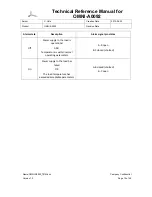
Technical Reference Manual for
OMNI-A0092
Author
C. Vale
Creation Date
2010-04-29
Product
OMNI-A0092
Revision Date
Name:OMNI-A0092_TRM.doc
Company Confidential
Version 1.0
Page 28 of 55
3.2 RF use
The antenna is designed to handle high RF drive powers. The following steps should be
adhered to before energising the antenna.
The non-ionising radiation emitted from the antenna during use,
as well as the high voltages (up to 1kV) generated between the
antenna and ground can cause serious injury or death to
personnel and civilians in the area of deployment. The antenna
should NEVER be energised when people or animals are at risk of
exposure. Operators should be sheltered in a metal enclosure at
all times.
3.2.1 Safety checks before energising the antenna
1)
The antenna should always be inspected once deployed, and before energising to
ensure that:
a.
There are no items, such as guy rope pegs, brackets, wet rags, etc possible
shorting out the radiator to the ground. The radiator is the part of the antenna
constituting the following: mast, steel wires, gin pole and hinge. The ground
constitutes objects such as: the base plate and mounting structure, the sprung
rollers, the winch and securing clamp at the back of the enclosure.
b.
The mechanism has properly and fully deployed.
c.
The guy ropes are secure and there is no chance of the antenna collapsing.
d.
The antenna is not in contact with any surround objects like tress, power lines
etc.
e.
There are no people in the surrounding areas who may approach the antenna
whilst in use.
f.
There is no possibility of adverse weather conditions, such as high winds,
heavy rain and lightning.
2)
The alarm state of the RF load can be read to ensure that it is OK.
3)
The remote controller of the mast is in the „up‟ position and the compressor has
power.
4)
All personnel should be in a metal shelter or located a safe distance from the
antenna and out of danger of the EM radiation before energising.
3.2.2 During energising
1)
The antenna is designed to be operated for long periods of time as high RF output
levels. During use at low frequencies it is normal for the RF load and parts of the
AMU to get hot.
















































